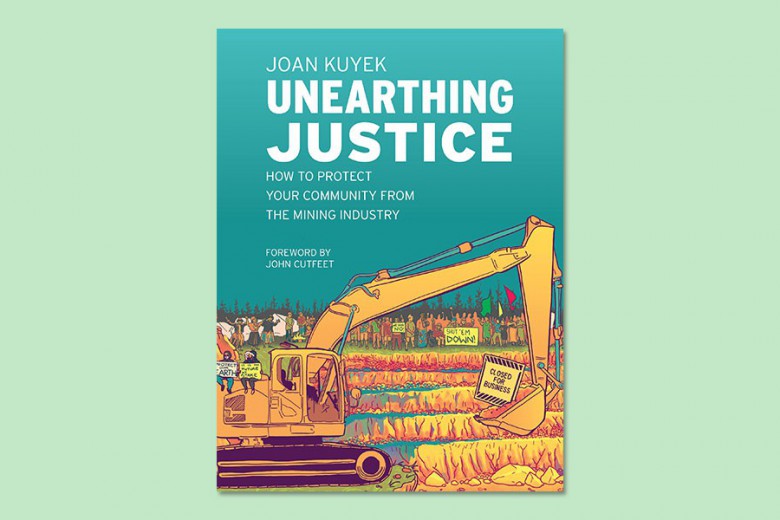Maehkaenah-Menaehsaeh (Turtle Island) has sustained people and other living things from time immemorial. Complex and interconnected systems of life make up its forests, rivers, lakes, prairies, and tundra. Beneath the ground, millions of years of intricate geological processes have resulted in deposits of copper, oil, and other metals and minerals, which Indigenous peoples have used for generations. In the eyes of the European colonists who began occupation in the 1400s, this land held a different kind of value. Ancient forests could be logged, and the timber sold or used to build ships, railroads, and settlements that would nourish population growth and stimulate the economies of their home countries through remittances. Copper, gold, coal, and other metals and minerals could be ripped from the Earth using industrial technologies that had irreversible effects on the environment.
Colonists envisioned Canada as a nation of white settlers, but they enlisted disposable, cheap, and exploitable labour, often indentured Chinese workers, to do the dangerous and frequently fatal work of creating railways, mines, and other drivers of the burgeoning capitalist economy. The Canadian state was formed from a distinct process of displacing Indigenous peoples from their land and using racialized labour to build infrastructure and to “tame” that land. The process of primitive accumulation (or accumulation by dispossession) that arose from both the resource extraction on Maehkaenah-Menaehsaeh, as well as the enslavement of African and other peoples, were, and remain, the major forces that allowed the capitalist world economy to emerge in the first place.
Extraction continues to play a central role in the capitalist economy. Canadian mining companies have a global presence, extracting vast amounts of capital from Indigenous lands on multiple continents and leaving forced displacement, armed conflict, pollution, and the murder, rape, torture, and imprisonment of union organizers and other activists in their wake. Between 2010 and 2014, natural resource sectors contributed C$27 billion per year to the Canadian state, evidence of the crucial role that extraction plays in state-building.
Dene scholar Glen Coulthard argues that primitive accumulation, rather than labour exploitation in the traditional capitalist sense, remains the most important vector in contemporary settler colonial oppression of Indigenous peoples. He writes: “It is now generally acknowledged among historians and political economists that following the waves of colonial settlement that marked the transition between mercantile and industrial capitalism (roughly spanning the years 1860–1914, but with variation between geographical regions) Native labour became increasingly (although by no means entirely) superfluous to the political and economic development of the Canadian state. Increased European settlement combined with an imported, hyper-exploited non-European workforce meant that, in the post-fur trade period, Canadian state-formation and colonial-capitalist development required first and foremost land, and only secondarily the surplus value afforded by cheap, Indigenous labour.”
As far as the colonial-capitalist project was – and is – concerned, Indigenous peoples are primarily viewed and treated as physical obstacles standing in the way of resource capital – rather than a source of exploitable labour, they are obstacles to be removed through violence, assimilation, criminalization, and other genocidal measures.
In the contemporary Canadian state, the overwhelming majority of wealth extracted from the Earth remains controlled by the settler population. The pursuit of resource capital drives industrial encroachment onto Indigenous lands as well as the criminalization and surveillance of Indigenous sovereignty movements. Natural Resources Canada unequivocally links resource extraction to capital: “Canada is blessed with a vast wealth of natural resources, which contributes significantly to our national economy. Resource industries play a critical role in delivering jobs, growth and prosperity for Canadians.” This prosperity, however, is reserved for settlers: many Indigenous people, particularly First Nations on reserves, are systematically deprived of access to proper medical care, potable water, adequate housing, and other vital necessities. In Saskatchewan, for instance, where over 90 per cent of First Nations have had at least one water advisory since 2004, the Saskatchewan-headquartered uranium producer Cameco has been in a dispute with the Canada Revenue Agency over an alleged C$2.1 billion in avoided taxes, a sum that could cover the costs of eliminating boil-water advisories on every reserve.
In a liberal political climate where corporations pay lip service, to some extent, to corporate social responsibility, many extraction companies and the provincial and federal bureaucracies that support them are increasingly promoting equity hiring practices and “partnerships” with First Nations. A Government of Canada strategy file on oil sands frames its hiring practices as a process of folding Indigenous peoples into the existing extractive-capitalist economy: “Aboriginal economic development is a priority for Canada…. Canada is working in partnership with First Nations, provincial and municipal governments, and industrial developers to help First Nations communities secure ongoing social and economic benefits from oil sands development.” But the hiring practices aren’t acts of benevolence. Jim Boucher, chief of the Fort McKay First Nation, notorious for the economic stimulus it has reaped from tarsands money, stated in 2014 that partnering with the oilsands was the community’s only option after the decline of the trapping economy, knowing full well that choosing to work with the industry realistically meant destruction of the land.
Extraction companies have long been using the pretext of job creation in Indigenous communities to obscure their ultimate objective: the expropriation of Indigenous lands and resources – if not through force, then through economic coercion.
In 1976, the Dryden Observer quoted the president of the Reed Paper Company – the same company responsible for the devastating mercury poisoning of the Grassy Narrows First Nation and Wabaseemoong Independent Nation – promising jobs and training programs to residents of the Pikangikum First Nation. Then-chief of Pikangikum, Ben Quill, blasted the offer of jobs, saying that introducing colonial industry to the community would not only “destroy the water and forest and everything,” but also be a path to assimilation and misery for future generations forced into a life of wage labour. Training a Pikangikum resident to operate forest-harvesting machinery, he said, would be tantamount to “giving him a gun and telling him to go out and shoot my people.”
Forty years later, extraction companies’ partnerships with Indigenous peoples have become glossier and more sophisticated, but a close look reveals these “partnerships” to be astoundingly asymmetrical. Barrick Gold’s Hemlo mines boast about hiring from “local Aboriginal communities,” yet only 10 per cent of their workers are local Indigenous people (Barrick does not disclose whether they are hired for skilled or unskilled jobs, nor does it report whether there are Indigenous workers who are not from local communities). A community-led study released in 2015 by Pauktuutit Inuit Women of Canada revealed that the Agnico-Eagle Mines-owned Meadowbank gold mine in Qamani’tuaq (Baker Lake), having negotiated an Impact Benefit Agreement (IBA) with an Inuit organization in 2011, failed to follow through on its promises of social and economic development for the community. At the end of 2012, almost 25 per cent of the mine’s workers were Inuit, though Inuit women made up a mere 6.5 per cent of the total permanent workforce of the mine, and most of their positions were unskilled and temporary ones. The mine’s presence and imposed work structure resulted in a more-than 100 per cent rise in alcohol consumption in Qamani’tuaq, a sharp increase in domestic disputes recorded by the RCMP, and harassment and racist comments directed at Inuit women by miners.
Prominent companies and extraction projects that claim to prioritize equity-hiring practices and partnerships with local Indigenous communities often do not list their hiring statistics, or fail to disclose who holds the high-paying, high-ranking, permanent positions. Since the higher-paying positions in mining and other industries often require specialized training offered mostly in urban areas, Indigenous people in systematically resource-deprived rural and northern areas, especially fly-in communities, are even less likely to access the marginal benefits of equity hiring.
Private corporate practices are emboldened by the state’s cheerleading of these colonial-capitalist strategies. While the Canadian government boasts that billions of dollars in oil contracts in the tarsands have been granted to Indigenous-owned companies, many in Indigenous communities emphasize that the contracts do not imply consent from an entire nation or band. In many cases, extraction companies are savvy enough to cherry-pick leaders who wish to partner with industry as a way of side-stepping the consent of communities in general – a strategy that recently led to the Haida nation’s ousting of two hereditary chiefs who supported Enbridge’s Northern Gateway pipeline.
A second form of evidence of Indigenous peoples positioned as surplus labour includes the colonial impulse to suggest that moving off the land and into cities will improve the economic and social conditions of Indigenous peoples in remote communities and on reserves. When the suicides of young people in Attawapiskat triggered a crisis, commentators like Maclean’s Scott Gilmore proselytized that residents of the North should move to cities in the south rather than staying in a non-industrialized home community (where, as it happens, people are better able to connect with the land and their traditional lifeways and extended family). Whereas life on reserves is seen as self-destructive and illogical, life in the cities is progress. No matter that migration to the cities leaves many Indigenous people facing police violence, loss of language and culture, discrimination in housing and job markets, homelessness, poverty, and extreme rates of violence against Indigenous women. No, jobs are apparently the remedy for colonialism … but more importantly – if less transparently – they are the means for clearing the resource-rich North.
The long-term, often-irreversible effects of extraction activities on the land, as well as the increases in substance misuse and violence against women associated with extraction, are well-known facts in areas affected by these activities. Conditions of lethal oppression and poverty in the North and on reserves, including lack of electricity and housing in extreme temperatures, underfunding of social services like education, health, and child welfare, and catastrophic rates of youth suicide, leave people with dismally few economic options. Many workers take jobs out of necessity, compelled by capitalism to work within and for industries they know are actively destroying the land and their abilities to maintain their traditional ways of life.
When extraction industries do offer communities tangible benefits, they are temporary due to the boom-and-bust nature of extractive development. Although communities often make the most out of the infrastructure left behind by extraction booms and people appreciate past prosperity and worker solidarity forged while jobs were available, the crisis of deindustrialization cannot be downplayed. Extraction projects mean that jobs, money, materials, resources, and knowledge enter remote areas in a whirlwind and leave just as quickly once the resource is exhausted – a phenomenon that political economist Harold Innis calls “cyclonics.”
Capitalism assimilates non-capitalist ways of being, quashing Indigenous communitarian economies. Imposing extractive industries on Indigenous people who are denied other options is a powerful way for capitalism to expand its reach and eliminate alternative livelihoods.
Simultaneously, groups such as the Unist’ot’en, which refuse extractive projects on their lands, face the ongoing threat of legal discipline and repression for exercising their internationally enshrined right to free, prior, and informed consent, and living traditionally on their territories. With declines in oil, pulp, and other industries, and growing support for Indigenous self-determination, it is more important than ever to stand in solidarity with Indigenous movements that are modelling alternatives that go beyond the liberal paradigm of equity hiring and inclusion. After all, in an age of widespread environmental catastrophe, the lives of all living things depend on it.







